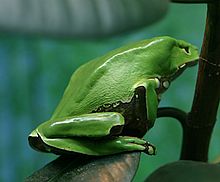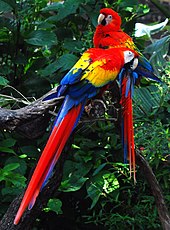The Amazon rainforest (Portuguese: Floresta Amazônica or Amazônia; Spanish: Selva Amazónica, Amazonía or usually Amazonia; French:Forêt amazonienne; Dutch: Amazoneregenwoud), also known in English as Amazonia or the Amazon Jungle, is a moist broadleaf forest that covers most of the Amazon Basin of South America. This basin encompasses seven million square kilometers (1.7 billion acres), of which five and a half million square kilometers (1.4 billion acres) are covered by the rainforest. This region includes territory belonging to nine nations. The majority of the forest is contained within Brazil, with 60% of the rainforest, followed by Peru with 13%, Colombia with 10%, and with minor amounts in, Venezuela, Ecuador, Bolivia, Guyana, Suriname and French Guiana. States or departments in four nations contain "Amazonas" in their names. The Amazon represents over half of the planet's remaining rainforests, and it comprises the largest and most species-rich tract oftropical rainforest in the world.
Contents[hide] |
Etymology
The name Amazon is said to arise from a war Francisco de Orellana fought with a tribe of Tapuyas and other tribes from South America. The women of the tribe fought alongside the men, as was the custom among the entire tribe.[1] Orellana derived the name Amazonas from the ancientAmazons of Asia and Africa described by Herodotus and Diodorus in Greek legends.[1]
History
Natural
The rainforest likely formed during the Eocene era. It appeared following a global reduction of tropical temperatures when the Atlantic Ocean had widened sufficiently to provide a warm, moist climate to the Amazon basin. The rain forest has been in existence for at least 55 million years, and most of the region remained free of savanna-type biomes at least until the current ice age, when the climate was drier and savanna more widespread.[2][3]
Following the Cretaceous–Paleogene extinction event, the extinction of the dinosaurs and the wetter climate may have allowed the tropical rainforest to spread out across the continent. From 65–34 Mya, the rainforest extended as far south as 45°. Climate fluctuations during the last 34 million years have allowed savanna regions to expand into the tropics. During the Oligocene, for example, the rainforest spanned a relatively narrow band that lay mostly above latitude 15°N. It expanded again during the Middle Miocene, then retracted to a mostly inland formation at the last glacial maximum.[4] However, the rainforest still managed to thrive during these glacial periods, allowing for the survival and evolution of a broad diversity of species.[5]
During the mid-Eocene, it is believed that the drainage basin of the Amazon was split along the middle of the continent by the Purus Arch. Water on the eastern side flowed toward the Atlantic, while to the west water flowed toward the Pacific across the Amazonas Basin. As the Andes Mountains rose, however, a large basin was created that enclosed a lake; now known as the Solimões Basin. Within the last 5–10 million years, this accumulating water broke through the Purus Arch, joining the easterly flow toward the Atlantic.[6][7]
There is evidence that there have been significant changes in Amazon rainforest vegetation over the last 21,000 years through the Last Glacial Maximum(LGM) and subsequent deglaciation. Analyses of sediment deposits from Amazon basin paleolakes and from the Amazon Fan indicate that rainfall in the basin during the LGM was lower than for the present, and this was almost certainly associated with reduced moist tropical vegetation cover in the basin.[8] There is debate, however, over how extensive this reduction was. Some scientists argue that the rainforest was reduced to small, isolatedrefugia separated by open forest and grassland;[9] other scientists argue that the rainforest remained largely intact but extended less far to the north, south, and east than is seen today.[10] This debate has proved difficult to resolve because the practical limitations of working in the rainforest mean that data sampling is biased away from the center of the Amazon basin, and both explanations are reasonably well supported by the available data.
More than half of the dust needed for fertilizing the Amazon rainforest is provided by the Bodélé depression in Sahara. Up to 50 million tonnes per year are windblown across the Atlantic Ocean.[11][12]
Human activity
Based on archaeological evidence from an excavation at Caverna da Pedra Pintada, human inhabitants first settled in the Amazon region at least 11,200 years ago.[13] Subsequent development led to late-prehistoric settlements along the periphery of the forest by AD 1250, which induced alterations in the forest cover.[14]
For a long time, it was thought that the Amazon rainforest was sparsely populated, as it was impossible to sustain a large population through agriculturegiven the poor soil. Archeologist Betty Meggers was a prominent proponent of this idea, as described in her book Amazonia: Man and Culture in a Counterfeit Paradise. She claimed that a population density of 0.2 inhabitants per square kilometre (0.52 /sq mi) is the maximum that can be sustained in the rain forest through hunting, with agriculture needed to host a larger population.[15] However, recent anthropological findings have suggested that the region was actually densely populated. Some 5 million people may have lived in the Amazon region in AD 1500, divided between dense coastal settlements, such as that at Marajó, and inland dwellers.[16] By 1900 the population had fallen to 1 million and by the early 1980s it was less than 200,000.[16]
The first European to travel the length of the Amazon River was Francisco de Orellana in 1542.[17] The BBC's Unnatural Histories presents evidence that Orellana, rather than exaggerating his claims as previously thought, was correct in his observations that a complex civilization was flourishing along the Amazon in the 1540s. It is believed that the civilization was later devastated by the spread of diseases from Europe, such as smallpox.[18]
Since the 1970s, numerous geoglyphs have been discovered on deforested land dating between AD 0–1250, furthering claims about Pre-Columbian civilizations.[19][20] Alceu Ranzi, a Brazilian geographer, is accredited with first discovering the geoglyphs whilst flying over Acre.[21] The BBC's Unnatural Histories presented evidence that the Amazon rainforest, rather than being a pristine wilderness, has been shaped by man for at least 11,000 years through practices such as forest gardening and terra preta.[18]
Terra preta (black earth), which is distributed over large areas in the Amazon forest, is now widely accepted as a product of indigenous soil management. The development of this fertile soil allowed agriculture andsilviculture in the previously hostile environment; meaning that large portions of the Amazon rainforest are probably the result of centuries of human management, rather than naturally occurring as has previously been supposed.[22] In the region of the Xingu tribe, remains of some of these large settlements in the middle of the Amazon forest were found in 2003 by Michael Heckenberger and colleagues of the University of Florida. Among those were evidence of roads, bridges and large plazas.[23]
Biodiversity
Wet tropical forests are the most species-rich biome, and tropical forests in the Americas are consistently more species rich than the wet forests in Africa and Asia.[24] As the largest tract of tropical rainforest in the Americas, the Amazonian rainforests have unparalleled biodiversity. One in ten known species in the world lives in the Amazon Rainforest.[25] This constitutes the largest collection of living plants and animal species in the world.
The region is home to about 2.5 million insect species,[26] tens of thousands of plants, and some 2,000 birds andmammals. To date, at least 40,000 plant species, 2,200 fishes,[27] 1,294 birds, 427 mammals, 428 amphibians, and 378 reptiles have been scientifically classified in the region.[28] One in five of all the bird species in the world live in the rainforests of the Amazon, and one in five of the fish species live in Amazonian rivers and streams. Scientists have described between 96,660 and 128,843 invertebrate species in Brazil alone.[29]
The biodiversity of plant species is the highest on Earth with some experts estimating that one square kilometer (247 acres) may contain more than a thousand types of trees and thousands of species of other higher plants. According to a 2001 study, a quarter square kilometer (62 acres) of Ecuadorian rainforest supports more than 1,100 tree species.[30]
One square kilometer (247 acres) of Amazon rainforest can contain about 90,790 tonnes of living plants. The average plant biomass is estimated at 356 ± 47 tonnes per hectare.[31] To date, an estimated 438,000 species of plants of economic and social interest have been registered in the region with many more remaining to be discovered or catalogued.[32]
The green leaf area of plants and trees in the rainforest varies by about 25% as a result of seasonal changes. Leaves expand during the dry season when sunlight is at a maximum, then undergo abscission in the cloudy wet season. These changes provide a balance of carbon between photosynthesis and respiration.[33]
The rainforest contains several species that can pose a hazard. Among the largest predatory creatures are the black caiman,
نظرات شما عزیزان:






